US Pharm. 2023;48(5):32-36.
Hypertension (HTN) is one of the strongest and most common modifiable risk factors for cardiovascular disease, the leading cause of death in the United States. This common chronic condition can potentially worsen and lead to other more dangerous conditions such as vision loss, chronic kidney disease, stroke, heart failure, and dementia. It is also the leading contributor to morbidity and mortality worldwide. In 2020, HTN was the primary cause of death for more than 670,000 people in the U.S. Approximately 116 million, or nearly one-half of the U.S. adult population, have HTN. What is even more concerning is that approximately 24% of people have their blood pressure (BP) under control, and about one in three adults are not aware that they have this condition. Many of these individuals have health insurance, have a primary care provider, and have been seen for care, suggesting that millions of people with uncontrolled HTN have been seen by a provider yet are undiagnosed and “hiding in plain sight.” HTN also places a high economic burden on our healthcare system, accounting for about $131 billion annually. To help reduce the risk of cardiovascular events as well as healthcare costs, it is imperative to increase awareness of HTN and the importance of managing it properly. Pharmacists can play an essential role in educating patients and increasing awareness of this public health challenge.1-6
Definition and Classification
HTN is essentially the manifestation of BP force dangerously increasing against arterial walls and through blood vessels. This pressure is composed of two forces: the systolic pressure and the diastolic pressure. Systolic BP (SBP) happens as blood is pumped out of the heart, while diastolic BP (DBP) refers to the resting state in between heartbeats. The American College of Cardiology (ACC)/American Heart Association (AHA) guideline defines high BP (HBP) as an SBP of at least 130 mmHg, a DBP of at least 80 mmHg, or reported treatment with antihypertensive medication. BP thresholds are generally based on the average of at least two measurements obtained in an office setting on at least two separate occasions and are categorized into four levels: normal, elevated, and stage I and II HTN (see TABLE 1).7
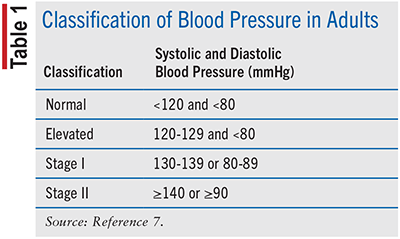
Risk Factors
HTN risk factors can be divided into modifiable and nonmodifiable risk factors. Nonmodifiable risk factors include family history, age over 65 years, and ethnicity, with certain ethnic groups such as African Americans, Pacific Islanders, and Hispanics at a higher risk for HTN development. Modifiable risk factors, or lifestyle factors, can have a greater impact on the development of HTN. These factors include being overweight, not participating in physical activity, poor diet, excess sodium intake, insufficient potassium intake, and excessive alcohol intake; abdominal adiposity, smoking, and physical inactivity also appear to play a major role in increasing an individual’s risk for HTN.7-9
Screening
The U.S. Preventative Services Task Force recommends screening all adults aged 18 years and older for HTN. Adults who are aged 40 years or older or who are at an increased risk for HTN should be screened annually. Screening can be done less frequently—about every 3 to 5 years—for those who are aged 18 to 39 years and not at an increased risk for HTN. The initial screening should be done with an office BP measurement (OBPM). The OPBM should be confirmed with ambulatory BP monitoring or home BP monitoring with validated and accurate devices outside of the clinical setting before treatment is initiated.10
Management
The overall goal of managing HTN is to reduce patients’ morbidity and mortality from cardiovascular events and to prevent other complications such as kidney disease and heart failure. The ACC/AHA guideline recommends a goal BP of less than 130/80 mmHg for most adults. To achieve this goal, approaches include both nonpharmacologic and pharmacologic interventions. For all patients with elevated BP or any stage of HTN, lifestyle modifications should be incorporated. The decision to start pharmacologic therapy is based on the patient’s risk for atherosclerotic cardiovascular disease and stage of HTN (see TABLE 2). This risk can be calculated by using the pooled cohort equations calculator that can be found on the ACC’s website (https://tools.acc.org/ascvd-risk-estimator-plus/#!/calculate/estimate/), downloaded as a mobile phone application, or embedded in a variety of clinical information software systems.7,11
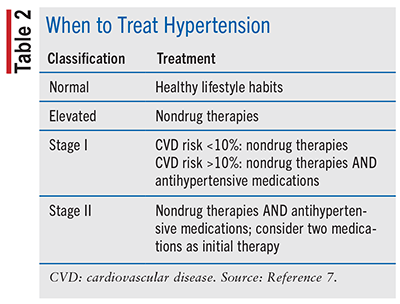
Nonpharmacologic Therapy
Lifestyle modifications are a necessity in the management of HTN. These modifications should include incorporating a heart-healthy diet, increasing potassium intake, reducing sodium intake and alcohol consumption, engaging in physical activity, and losing weight. These interventions alone can reduce mean SBP by about 5 mmHg in patients with HTN and by 2 to 3 mmHg in patients without HTN.
Diets, such as the Dietary Approaches to Stop Hypertension diet and the Mediterranean diet, have been shown to provide favorable effects on the risk of HTN. Not only do they promote healthier eating but they also help with reducing sodium intake and increasing potassium intake. It has been shown that a 1,000-mg sodium reduction results in a lowering of SBP by 3 mmHg, and a 0.6 g/day-increase in potassium intake results in a 1 mmHg-reduction in SBP. These diets are rich in fruits, vegetables, whole grains, olive oil, nuts, and seeds, with reduced amounts of saturated and total fat and consumption of alcohol (two or fewer drinks daily for men and one or fewer drinks daily for women). A diet that includes more of these potassium-, calcium-, and magnesium-dense foods and less red meats, sodium, and saturated fats has resulted in lower SBP, with overall reductions up to 11 mmHg, allowing for better BP control.7,12,13
Physical inactivity is a major risk factor for HBP; just like a heart-healthy diet, exercise is a key component to the management of HTN. Although aerobic exercises such as walking, swimming, dancing, and cycling can help lower BP, there is evidence to support the benefits of dynamic resistance exercise and static isometric exercises on BP. Exercise has been shown to reduce SBP by an average of 5 to 8 mmHg and DBP by 3 mmHg. Patients should be aiming for at least 150 minutes per week of moderate-intensity physical activities, such as brisk walking. By starting slowly with low-intensity workouts and building up stamina and strength to higher-intensity intervals, patients can slowly reduce their risk and make their hearts healthier.7,14,15
Weight loss is another important contributor to better BP control. By reducing caloric intake and increasing physical activity, weight loss can be achieved. Modest weight loss can have a positive impact on BP; a 2- to 4-kg reduction in weight has been shown to decrease SBP by 3 to 8 mmHg. Ideally, the approach to weight loss should be gradual, with a weekly goal of 1 to 2 kg.7,16
Other lifestyle modifications include smoking cessation and discontinuing alcohol consumption. When counseling patients with HTN who are struggling with smoking cessation, it is best to help patients decide when they are ready and formulate a plan together, because if theyare not willing, it becomes more difficult to adhere to a plan. Nicotine lozenges, patches, and gum are various ways to initiate cessation, depending on the individual patient.
Pharmacologic Therapy
There are many options for the treatment and management of HTN if lifestyle modifications alone are insufficient alone to achieve BP control (see TABLE 3). The ACC/AHA recommends thiazide diuretics, calcium channel blockers, and angiotensin-converting enzymes or angiotensin receptor blockers as first-line therapies. These agents have been shown to reduce clinical events. Many patients can be started on one agent but will ultimately need two or more agents from different classes to control their BP. Patients with stage II HTN should initially be started with two medications from different classes.7,11
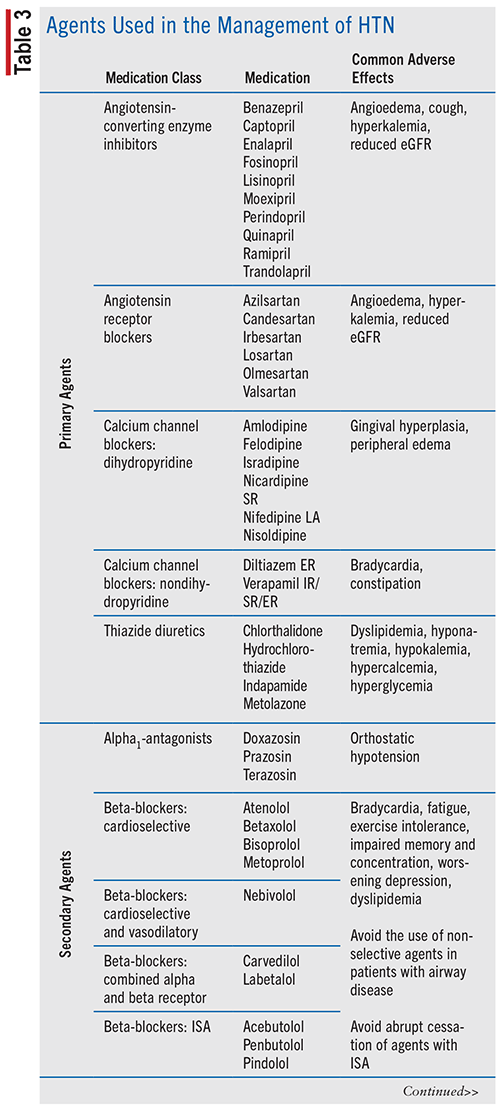
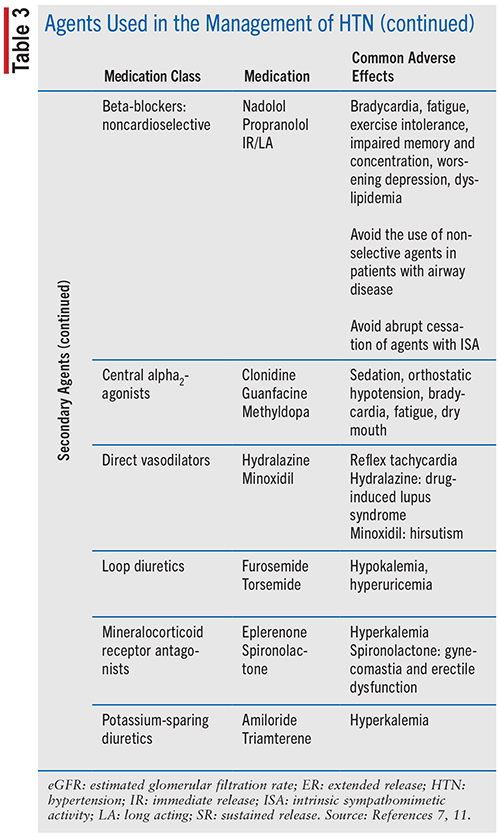
Despite the available drug therapies and nonpharmacologic interventions, almost 75% of patients do not have their HTN under control. Several factors may contribute to this poor control. These factors include suboptimal dosing or treatment intensification or poor drug choice, limited access to or use of healthcare, and poor adherence to prescribed antihypertensive treatment or other lifestyle recommendations. These factors highlight that there are many contributors to why patients are not achieving control, but medication adherence remains an important target to improve overall HTN control. Approximately 12% of patients with HTN never fill initial prescriptions. Findings have demonstrated that adherence with hypertensive pharmacotherapy 1 year after initiation is reported to be on average less than 50%. This can lead to negative outcomes, increasing the risk of cardiovascular events and stroke.17-19
Role of the Pharmacist
Pharmacists can play a critical role in HTN management by working collaboratively with patients, physicians, and other healthcare providers to improve BP control and prevent complications. The CDC recognizes the contribution pharmacists can make to improve public health and has published a comprehensive resource guide, “Using the Pharmacists’ Patient Care Process to Manage High Blood Pressure: A Resource Guide for Pharmacist,” as a call to action for pharmacists to prevent and manage HBP through team-based care. Pharmacists are experts in medication management and can work with patients to optimize their medication regimens to improve BP control. They can also help patients manage side effects and work with providers to optimize drug therapy and lifestyle modifications. Pharmacists can work collaboratively with physicians and other healthcare providers to ensure that patients receive comprehensive care for HTN. Proper education and awareness are imperative in counseling a patient regarding nonpharmacologic treatments and therapies. Pharmacists can provide education to patients on HTN, including the importance of BP control, the role of medications, and lifestyle modifications that can help improve BP control. In addition, pharmacists should play an active role in identifying patients who may be nonadherent to their regimens. Pharmacists should work closely with their patients to understand and address the underlying factors that contribute to nonadherence, such as forgetfulness, medication side effects, and cost concerns, among others. Another service pharmacists can provide is to help monitor patients’ BP and provide regular feedback to help patients and healthcare providers make informed decisions about medication management and lifestyle modifications.20-22
Conclusion
HTN has been dubbed the “silent killer” because it typically does not cause any symptoms, even when BP is significantly elevated. Many people with HTN are unaware that they have the condition, and it can go undiagnosed and untreated for years, leading to significant damage to the cardiovascular system, including the heart, blood vessels, and kidneys. Over time, uncontrolled HTN can lead to an increased risk of heart disease, stroke, kidney disease, and other serious health problems. It is important for individuals to have their BP checked regularly, especially if they have risk factors for HTN such as a family history of HBP, obesity, or a sedentary lifestyle. Lifestyle modifications play a critical role in HTN management, reducing BP and improving overall cardiovascular health. In conjunction with lifestyle modifications, many patients will also be on medication management, but many are nonadherent. Pharmacists need to work with both their patients and other healthcare providers to help increase awareness of this silent killer to help prevent or delay the onset of serious health complications through the provision of patient education, medication therapy management, medication adherence support, and BP monitoring services.
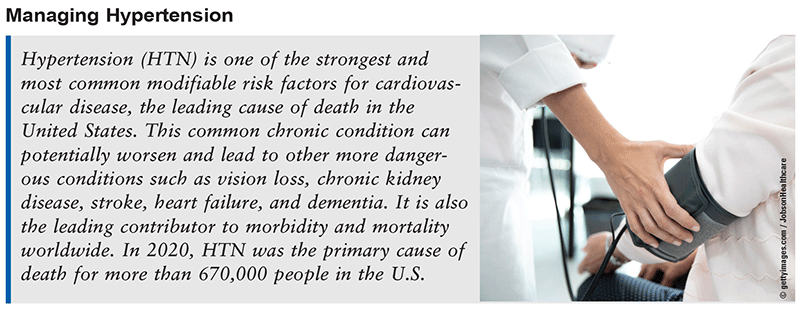
What Is High Blood Pressure?
High blood pressure (HBP), or hypertension, is when the force of the blood pushing against your arteries is too strong. There are two types of blood pressure (BP) numbers: systolic and diastolic. The top number (the systolic pressure) measures the pressure when your heart beats. The bottom number (the diastolic pressure) measures the pressure when your heart is relaxed. For most people, normal BP is 120/80 mmHg. HBP is one where it is consistently higher than 130/80 mmHg.
What Are the Symptoms of HBP?
HBP does not usually have any warning signs or symptoms. Many people do not even know they have HBP. That is why it is sometimes called the “silent killer.” Having HBP for a long time can lead to serious complications, such as heart attack, stroke, kidney disease, and vision problems. It is very important to have your BP checked at least once a year by your healthcare provider.
What Are the Risk Factors for HBP?
Your age puts you at risk. As you age, your BP tends to get higher. Family history is also another factor. HBP often runs in the family. More importantly, your lifestyle habits play a big role. Eating unhealthy foods, not exercising or moving, consuming too much salt, drinking too much alcohol, and being overweight or obese are major risk factors and can lead to HBP.
How Can I Reduce My Risk for HBP?
The most important way to prevent HBP is to eat a healthy diet, reduce your salt intake, get at least 30 minutes of exercise most days of the week, avoid smoking, and limit alcohol.
How Is HBP Treated?
Many people can lower their BP just by making healthy lifestyle changes. Some people may need medicines to help lower their BP in addition to lifestyle changes. Take your medicines as directed, even if you are feeling fine. Remember, there are usually no signs or symptoms of HBP. If you forget to take your medicine or skip doses, your BP will not be controlled. Lowering your BP can save your life. HBP can be lowered with the right treatment plan and regular visits with your healthcare provider. Work with your healthcare team to find a plan that is right for you.
Where Can I Get More Information?
You can visit the following websites for additional support and resources: CDC: https://www.cdc.gov/bloodpressure/
National Heart, Lung, and Blood Institute: https://www.nhlbi.nih.gov/health-topics/education-and-awareness/high-blood-pressure/publications-patients
REFERENCES
1. CDC. Facts about hypertension. January 5, 2023. www.cdc.gov/bloodpressure/facts.htm. Accessed April 1, 2023.
2. GBD 2015 Risk Factors Collaborators. Global, regional, and national comparative risk assessment of 79 behavioural, environmental and occupational, and metabolic risks or clusters of risks, 1990-2015: a systematic analysis for the Global Burden of Disease Study 2015. Lancet. 2016;388(10053):1659-1724.
3. CDC. 5 Surprising facts about high blood pressure. December 13, 2022. www.cdc.gov/bloodpressure/5_surprising_facts.htm. Accessed April 1, 2023.
4. Kirkland EB, Heincelman M, Bishu KG, et al. Trends in healthcare expenditures among US adults with hypertension: national estimates, 2003-2014. J Am Heart Assoc. 2018;7(11):e008731.
5. Wall HK, Hannan JA, Wright JS. Patients with undiagnosed hypertension: hiding in plain sight. JAMA. 2014;312(19):1973-1974.
6. Ahuja R, Ayala C, Tong X, et al. Public awareness of health-related risks from uncontrolled hypertension. Prev Chronic Dis. 2018;15:E40.
7. Whelton PK, Carey RM, Aronow WS, et al. 2017 ACC/AHA/AAPA/ABC/ACPM/AGS/APhA/ASH/ASPC/NMA/PCNA Guideline for the Prevention, Detection, Evaluation, and Management of High Blood Pressure in Adults: a report of the American College of Cardiology/American Heart Association Task Force on Clinical Practice Guidelines. Hypertension. 2018;71(6):e13-e115.
8. CDC. Know your risk for high blood pressure. March 17, 2023. www.cdc.gov/bloodpressure/risk_factors.htm. Accessed April 1, 2023.
9. Andriolo V, Dietrich S, Knüppel S, et al. Traditional risk factors for essential hypertension: analysis of their specific combinations in the EPIC-Potsdam cohort. Sci Rep. 2019;9(1):1501.
10. U.S. Preventive Services Task Force. Screening for hypertension in adults: U.S. Preventive Services Task Force reaffirmation recommendation statement. JAMA. 2021;325(16):1650-1656.
11. Carey RM, Moran AE, Whelton PK. Treatment of hypertension: a review. JAMA. 2022;328(18):1849-1861.
12. Cicero AFG, Veronesi M, Fogacci F. Dietary intervention to improve blood pressure control: beyond salt restriction. High Blood Press Cardiovasc Prev. 2021;28(6):547-553.
13. Bazzano LA, Green T, Harrison TN, Reynolds K. Dietary approaches to prevent hypertension. Curr Hypertens Rep. 2013;15(6):694-702.
14. Hegde SM, Solomon SD. Influence of physical activity on hypertension and cardiac structure and function. Curr Hypertens Rep. 2015;17(10):77.
15. Barone Gibbs B, Hivert MF, Jerome GJ, et al. Physical activity as a critical component of first-line treatment for elevated blood pressure or cholesterol: who, what, and how?: a scientific statement from the American Heart Association. Hypertension. 2021;78(2):e26-e37.
16. Harsha DW, Bray GA. Weight loss and blood pressure control (Pro). Hypertension. 2008;51(6):1420-1425.
17. Million Hearts. Estimated hypertension prevalence, treatment, and control among U.S. adults. March 22, 2021. https://millionhearts.hhs.gov/data-reports/hypertension-prevalence.html. Accessed April 1, 2023.
18. Choudhry NK, Kronish IM, Vongpatanasin W, et al. Medication adherence and blood pressure control: a scientific statement from the American Heart Association. Hypertension. 2022;79(1):e1-e14.
19. Burnier M, Egan BM. Adherence in hypertension. Circ Res. 2019;124(7):1124-1140.
20. Di Palo KE, Kish T. The role of the pharmacist in hypertension management. Curr Opin Cardiol. 2018;33(4):382-387.
21. Wagner TD, Jones MC, Salgado TM, Dixon DL. Pharmacist’s role in hypertension management: a review of key randomized controlled trials. J Hum Hypertens. 2020;34(7):487-494.
22. CDC. Pharmacists’ patient care process approach guide. August 27, 2021. www.cdc.gov/dhdsp/evaluation_resources/guides/pharmacists_patient_care.htm. Accessed April 21, 2023.
The content contained in this article is for informational purposes only. The content is not intended to be a substitute for professional advice. Reliance on any information provided in this article is solely at your own risk.
To comment on this article, contact rdavidson@uspharmacist.com.





